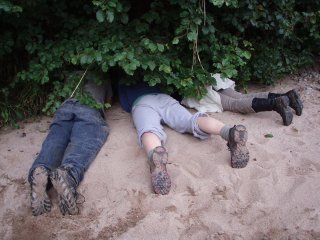Category: Off the beaten track
Tracking is something anyone can do. As any good detective knows, piecing together a puzzle is all about making observations and asking the right questions…
Warning: tracking is highly addictive, and may result in forgetting about the to do list, contagious curiosity, enhanced obsession with wildlife, grinning and head scratching, muddy knees, and potentially irreversible nature connection. Proceed at your own risk.

So, brave reader, the questions – Who? What? When? Where? Why and How? – are what American tracker Jon Young calls the ‘six arts of tracking’.
Who? This is the art of identification. Ask yourself: what size and shape is the print? How many toes are visible (remember that not all toes may show!)? Can I see claw prints? Which animals live in this area? Perhaps make a sketch and take a photo, then check out some field guides at home.
What? This question is about interpretation. What was the animal doing? Watch animals moving and you can start to get an understanding of gaits. Was it trotting, galloping or stalking? It takes practice to work this out, but it’s fun trying, and even more fun imitating different gaits to get a visceral understanding of body mechanics. It’s one of the most hilarious forms of exercise out there!
When? Accurate ageing can take a lot of practice, but we can still make an educated guess. Looking closely at a badger print, you see the marks made by rain all around the track, but none within it. You remember the most recent rain ended around 11am yesterday morning. As badgers usually emerge around dusk you can safely assume this track was made last night.
Where? Trailing is the art of locating an animal. Attached to a footprint is a string of prints and sign leading to the animal itself. To get your eye in for subtle sign, challenge yourself to find ten tracks in a row, without skipping any! With practice you will be able to follow trails without having to find every print. Playing ‘tracking hide and seek’ with friends helps hone this skill!
Why? Ecological tracking involves taking a bird’s-eye view of the scene. Why was this animal using this trail at that particular time? Think about what different animals need in terms of shelter, food, water, sex and safety, and you’ll find that animals are constantly being ‘pushed’ or ‘pulled’ by the demands of survival.
How? This is where empathy and intuition come into play. How was this animal feeling, or what was its mind state when it passed by? Of course this may be very difficult and often impossible to work out for sure, but with practice we can start to see more from an animal’s perspective. Sometimes it may be quite obvious in the tracks, whether it’s the primal fear of a roe deer fleeing a lynx or human, or the exuberance of a dog fetching a ball on the beach.
So, step out the door, stop at the first track you find, pick one question or several and let the investigation begin!
Dan Puplett
Follow the link to find out about Dan’s Wildlife Tracking course with the Field Studies Council.
